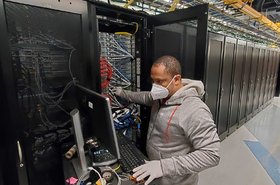The effects of the Covid-19 pandemic have been vast and all-encompassing. Indeed, with strict social distancing measures and nationally enforced lockdowns to contend with, for businesses everywhere this has meant having to adapt to a strange new set of circumstances.
That said, one silver lining throughout the course of the pandemic is that it has sparked some of the largest digital transformation projects that the private sector has ever seen. According to a recent report by Gartner, a staggering 88 percent of workers have been encouraged to work from home, and in order to cope in this “new normal”, organizations have migrated their processes online and overwhelmingly turned to digital communication platforms.
By and large, this transition to remote working has been a success. With employees now able to work more flexibly, many have found themselves more productive and even happier as a result of the changes. So much so, in fact, that 82 percent of business leaders plan to maintain a partial work-from-home structure even after Covid-19 is no longer a threat.
If this is to be the case, then business leaders should bear one important and recently neglected factor in mind. As staff swapped their offices for their kitchen tables, the subject of workplace learning and development (L&D) was placed on the backburner, and the statistics tell a troubling story. Workplace learning has actually emerged as one of the hardest-hit business activities on a global scale, with roughly one-half of in person programs cancelled or postponed in North America. Worse yet, in some parts of Asia and Europe, the figure is closer to 100 percent.
Now, as businesses settle into the swing of things in terms of their day-to-day, it is time for HR departments to reconsider how they can redouble their efforts to support professional growth, and give their employees the skills they need to thrive in an increasingly digital arena.
The future is digital
It goes without saying that companies have largely relied on digital solutions to withstand the impact of COVID-19. The same should now be said for staff development opportunities, as the pandemic stretches into the new year and beyond.
Thankfully, e-learning tools have been the order of the day, and business leaders seem keen to embrace new digital offerings, rather than relying on old-fashioned classroom-led sessions. Significantly, recent research conducted by Fountech.ai revealed that most businesses (54 percent) are now looking to tech to bolster their operations.
And while it is encouraging that organizations plan to focus their investment efforts on productive tech solutions, I would urge HR departments to put people-first technologies at the heart of their plans for digital transformation. In particular, businesses should reflect on successes and areas for improvement occurring throughout the pandemic.
The widespread use of connectivity and communication platforms has been a boon to businesses during this difficult period, but business leaders should now interrogate how well their current software fits the needs of their staff. They should ask questions such as: is the software user-friendly? Have employees been able to do their jobs effectively since going online? Have any skills gaps been exposed? In doing so, businesses might find areas for improvement, and in some cases, this will mean switching to a better offering.
Another area for exploration would be the use of data analytics to assess employee satisfaction and performance. Although popular belief might suggest that acquiring these insights can be obtrusive and indiscreet, this needn’t be the case. By conducting virtual questionnaires, online projects and classes, and even more informal Zoom meetings, HR managers can ask the important questions and assess how well employees are coping with the transition.
This data can then be put to good use in the planning of future L&D frameworks. Business leaders can truly personalize their efforts, offering staff more support with their day-to-day and ample opportunities to upskill in areas of their choosing.
Delivering personalized learning
One major benefit of the shift to digital is the power of technology to democratize learning; a benefit that extends into the corporate learning space. This is particularly important given the variation in skill investment that we can expect within, and between, businesses.
The Social Mobility Commission’s 2019 Adult Skills Gap report notes that larger companies with better developed HR strategies generally prioritize high-qualified workers in senior positions for skill investment. Meanwhile, almost twice as many people in managerial, professional and associate professional occupations have access to training (30 percent) compared to those in intermediate (16 percent) or routine and manual occupations (18 percent).
Evidently, there is still work to be done to ensure not only that all employees have access to upskilling and reskilling opportunities, but also that the training delivered is catered to their needs.
The rise of online resources has made it easier and cheaper to provide access to education, with programmes and courses available to develop skills from coding to public speaking and successful negotiation tactics. Companies ought to bear this in mind as they determine which resources might be best placed to support staff at different levels, of different skillsets, and with varying career aspirations.
Rethinking soft skills
The geographical barriers inspired by the pandemic can largely be solved by replacing unfeasible in-person training with virtual sessions. Unfortunately, the same can’t be said for the topic of a skills gap in general.
As the pace of technology adoption accelerates, conventional wisdom might leave many professionals with the impression that their digital skills should be the ones in need of refining to thrive in the future jobs market. And this isn’t strictly untrue; according to a report from the World Economic Forum, there is surging demand for workers who can fill roles at the forefront of the data and artificial intelligence (AI) economy.
Yet, it is equally true that in the future, there will come a time when machines will overwhelmingly take over the grunt-work that many have become accustomed to. Without labour-intensive, repetitive taskwork like data entry and analysis to be concerned with, recruiters will be on the lookout for a much broader set of skills. Qualities such as leadership skills, communication skills, and even general attitude will all come to the fore, and businesses will be in need of people to work with and interpret the work of their technological counterparts.
As a result, HR leaders should make soft skills a prime focus when developing their plans for professional growth, in order to guarantee that their staff can thrive as technology progresses. Usually, skilled leaders who excel in these areas are the best people to lead soft skills sessions. This can be done virtually, and even on a 1:1 basis for those who require this training to progress in their roles.
An exciting prospect for the future, too, is that these sessions could even take place through virtual reality (VR) headsets, or high-end virtual moderated classrooms for a more personalized experience. Indeed, the need for human oversight will soon fall away entirely: AI-powered platforms capable of bestowing knowledge and understanding through natural language Q&A will soon enable employees to learn at their own pace, and in their own time.
While the pandemic has presented organizations with a number of obstacles to their HR efforts, I would encourage leaders to see this as a window of opportunity to transform their workplace L&D for the better. By providing their employees with the skills they need to thrive in an increasingly automated future, businesses can set plans in motion for the future of the workplace.





